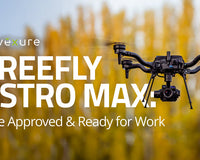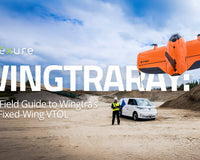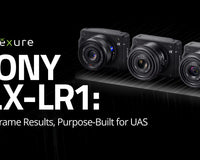Emlid has earned a reputation for making high-precision GNSS receivers accessible to professionals who need reliability without complexity. Whether used for surveying, photogrammetry, or drone mapping, Emlid’s receivers combine survey-grade accuracy with straightforward workflows, helping teams collect precise data in the field without steep learning curves or price tags.
On October 6th, 2025, Emlid introduced the next evolution of its lineup: the Reach RS4, Reach RS4 Pro, and Reach RX2. Each is built on a redesigned platform that focuses on speed, accuracy, and collaboration, marking the most significant update since the RS3’s release.
The RS4 series brings several top-level improvements: a next-generation tilt engine that initializes in seconds, full-band GNSS tracking (L1 through L6) for stronger performance under canopies, and a durable new magnesium alloy body rated for all-weather use.
The RS4 Pro takes things even further with dual cameras, AR-guided stakeout, and image-based measurement, creating new possibilities for visual and remote surveying that go beyond traditional RTK.
In the sections ahead, we’ll explore how these advancements translate into real-world impact for professionals as well as the key differences between RS4, RS4 Pro, and RS3.
RS4 and RS4 Pro at a Glance

Reach RS3: established Emlid as a trusted name in survey-grade GNSS receivers. It’s simple, dependable, and accurate enough for professionals across construction, mapping, and GIS.
Reach RS4: builds on that foundation with next-generation tracking, a stronger radio system, and a tougher magnesium alloy body for even greater reliability in the field.
Reach RS4 Pro: takes the RS4 platform further, integrating dual cameras and AR-guided workflows that redefine how crews perform stakeout and measure inaccessible points.
Below is a quick reference comparison of the three receivers and their key technical specifications.
|
Feature |
Reach RS3 |
Reach RS4 |
Reach RS4 Pro |
|---|---|---|---|
|
Ingress Protection |
IP67 |
IP68 |
IP68 |
|
Operating Temperature |
−20°C to +65°C |
−40°C to +65°C |
−40°C to +65°C |
|
Dimensions |
126 × 126 × 142 mm |
128.6 × 128.6 × 99.3 mm |
128.6 × 128.6 × 99.3 mm |
|
Weight |
950 g |
920 g |
920 g |
|
Battery Life (RTK / Logging) |
18 hrs / 22 hrs |
16 hrs / 22 hrs |
16 hrs / 22 hrs |
|
Battery Capacity |
5200 mAh, 7.2 V, 37.44 Wh |
5000 mAh, 7.2 V, 36 Wh |
5000 mAh, 7.2 V, 36 Wh |
|
Charging |
USB-C, 5 V / 3 A |
USB-C PD, 5–15 V / 3 A |
USB-C PD, 5–15 V / 3 A |
|
Bluetooth Version |
4.0 / 2.1 EDR |
5.1 (BR/EDR + LE) |
5.1 (BR/EDR + LE) |
|
GNSS Channels |
184 |
672 |
672 |
|
Signals Tracked |
GPS/QZSS, GLONASS, BeiDou, Galileo |
GPS, GLONASS, Galileo, BeiDou, QZSS, NavIC |
GPS, GLONASS, Galileo, BeiDou, QZSS, NavIC |
|
Radio Configuration |
LoRa TX/RX, UHF RX only |
LoRa TX/RX, UHF TX/RX |
LoRa TX/RX, UHF TX/RX |
|
IMU (Tilt Compensation) |
6DOF |
6DOF |
6DOF |
|
Imaging |
— |
— |
Dual Full-HD cameras for AR and visual workflows |
|
Drone Compatibility |
Yes |
Yes |
Yes |
Performance and Positioning Accuracy

The Reach RS4 series represents a significant leap in signal tracking and real-world reliability. Both the RS4 and RS4 Pro now support all global constellations and frequency bands (from L1 through L6) enabling centimeter-level precision even in challenging environments such as dense forests or urban canyons.
With a total of 672 channels, these receivers can track more satellites simultaneously and maintain a fix under conditions that would typically disrupt older units.
Initialization speed has also improved dramatically. The RS4 and RS4 Pro achieve a fixed RTK solution in roughly five seconds, matching or exceeding high-end GNSS systems at a fraction of the cost.
Compared to the RS3’s 184-channel architecture, users will notice faster convergence, better multipath resistance, and stronger signal retention near reflective surfaces or obstructions.
For professionals relying on post-processing, both RS4 models continue to deliver precise PPK and PPP capabilities through Emlid Flow 360 and Emlid Studio.
Tilt Compensation and Field Efficiency

Tilt compensation has always been one of Emlid’s biggest workflow accelerators, and the RS4 series refines it to near-instant readiness.
Both the RS4 and RS4 Pro use a new IMU algorithm that initializes in just a few seconds with a few natural movements, maintaining consistent accuracy even at steep tilt angles. For crews in the field, this means less downtime calibrating and more time collecting data.
In practice, this generation of tilt technology allows surveyors to capture points faster in tight or obstructed areas without worrying about keeping the pole perfectly vertical. Precision at 30 degrees of tilt still falls well within a couple of centimeters, giving users the confidence to work efficiently around vehicles, walls, or fencing where a traditional setup would’ve slowed them down.
Emlid also redesigned the physical mount for these tilt workflows. The new quick-release adapter system removes backlash between the receiver and the survey pole, so the pole’s motion doesn’t introduce small measurement errors during tilt-based stakeouts.
Radios, Connectivity, and Team Collaboration
One of the more meaningful upgrades in the RS4 series comes from its expanded connectivity. The RS3 introduced both LoRa and UHF radios but only supported receiving on the UHF band.
The RS4 and RS4 Pro now enable transmit and receive functionality on both radio systems, significantly expanding how crews can configure their equipment in the field.
The LoRa module supports up to 1 watt of power, license-free in most North American regions, and the UHF module can transmit at up to 2 watts (subject to local licensing). This dual-band, dual-direction design lets the RS4 series act as either a base or rover without needing additional hardware or an external radio. For multi-unit setups, that means faster deployment, simplified pairing, and consistent link quality across teams working across large or obstructed job sites.
Beyond radios, the RS4 series improves network versatility with an upgraded LTE modem, faster Wi-Fi, and Bluetooth 5.1 connectivity. In connected environments, users can easily run RTK corrections through NTRIP or Emlid’s own Caster service, sharing data with up to ten rovers at once.
Together, these improvements eliminate one of the biggest friction points for field teams: deciding how to stay connected. RS3 users often had to plan around network availability or external radios; the RS4 and RS4 Pro eliminates those roadblocks.
Hardware, Build Quality, and Battery Life

The RS4 series marks a shift toward a more rugged and professional-grade build, engineered for field crews who demand both portability and endurance.
The Reach RS3 was already known for its durability, with an IP67 rating and a high-strength polycarbonate housing. The RS4 and RS4 Pro take that durability a step further with a magnesium alloy body, chosen for its strength-to-weight ratio and thermal stability. This update results in a receiver that is lighter, tougher, and better at dissipating heat during long operations.
Environmental protection has also been enhanced. Both the RS4 and RS4 Pro carry an IP68 rating, offering complete resistance to dust ingress and the ability to withstand continuous immersion in water. Combined with a wide operating temperature range of −40°F to +149°F (−40°C to +65°C).
Power management remains a key strength across all models. The RS4 series uses an internal 5000 mAh lithium-ion battery, capable of running for up to 16 hours of continuous operation. The battery is optimized for cold-weather performance and fast recharging through USB-C Power Delivery, allowing users to top up in the field using standard power banks.
Altogether, these design updates make the RS4 platform more resilient, adaptable, and dependable.
RS4 Pro’s Dual Cameras and AR Stakeout
The Reach RS4 Pro sets itself apart from every receiver before it by integrating dual Full-HD cameras into the hardware, bringing visual context directly into the GNSS workflow. These cameras power two core capabilities that redefine how crews handle stakeout and measurement: AR-guided stakeout and image-based measurement.
AR Stakeout
With AR stakeout, survey points and CAD designs are overlaid directly onto a live camera view, letting crews navigate visually instead of relying on map coordinates. The display dynamically switches between front and bottom camera perspectives, complete with auto bullseye and cut-and-fill indicators. On complex construction sites or during road layout work, this visual guidance helps teams identify stakeout points faster and with fewer errors.
Image-Based Measurement

Image-based measurement adds another dimension to the RS4 Pro’s versatility. Users can measure points that are physically inaccessible (e.g. across roads, behind fences, above pits, or even over water) by capturing and processing images through the onboard cameras. The system automatically extracts coordinates from those visuals, removing the need for total stations or secondary tools.
Together, these features make the RS4 Pro far more than a GNSS receiver. It becomes a visual surveying platform, blending centimeter-level accuracy with real-time visual context.
Which Emlid Receiver Fits Your Workflow?
Each receiver in Emlid’s new lineup serves a distinct role. Whether your focus is precision, simplicity, or innovation, the table below can help you identify which model best supports your field operations.
|
Receiver |
Who It’s For |
|---|---|
|
Reach RS3 |
Professionals who need a dependable, survey-grade GNSS receiver for everyday RTK and PPK work. Ideal for construction, land surveying, and mapping workflows that prioritize reliability over new features. |
|
Reach RS4 |
Users who want a flagship receiver with full-band tracking (L1–L6), faster tilt performance, dual-band radios, and a tougher magnesium alloy body. Built for teams that balance precision with versatility in demanding environments. |
|
Reach RS4 Pro |
Surveyors and engineers who need advanced visual workflows, AR-guided stakeout, and image-based measurement. Perfect for complex sites, safety-sensitive areas, or projects where total stations once filled the gap. |
|
Reach RX2 |
Compact, lightweight, and ideal for mobile crews using NTRIP corrections. Suited for GIS data collection, drone mapping, and quick point verification where portability and simplicity matter most. |
Emlid's Software Ecosystem
Every Emlid receiver is supported by a unified software suite designed to connect the field, office, and cloud. At its core is Emlid Flow, the mobile application for configuring receivers, logging RINEX data, and managing surveys in real time. It simplifies setup, stakeout, and data collection through an intuitive interface available on both iOS and Android.
In the office, Emlid Flow 360 extends those capabilities to the cloud. Teams can prepare projects, manage datasets, and instantly sync updates between devices. This ensures that every team member works from the same live data.
For post-processing, Emlid Studio provides free desktop software for static, kinematic, and RTK data analysis, while Emlid Caster makes it easy to share corrections between multiple receivers through the internet.
The Next Chapter in Emlid’s Evolution
The Reach RS4 and RS4 Pro mark a defining step forward for Emlid. From their redesigned magnesium housings to faster tilt workflows, full-band GNSS support, and expanded connectivity, these receivers show how Emlid continues to refine survey technology for professionals who value efficiency, reliability, and control.
Pre-orders are now open for all three models. The Reach RX2 begins shipping in November 2025, while the Reach RS4 and RS4 Pro will ship in late December 2025.










